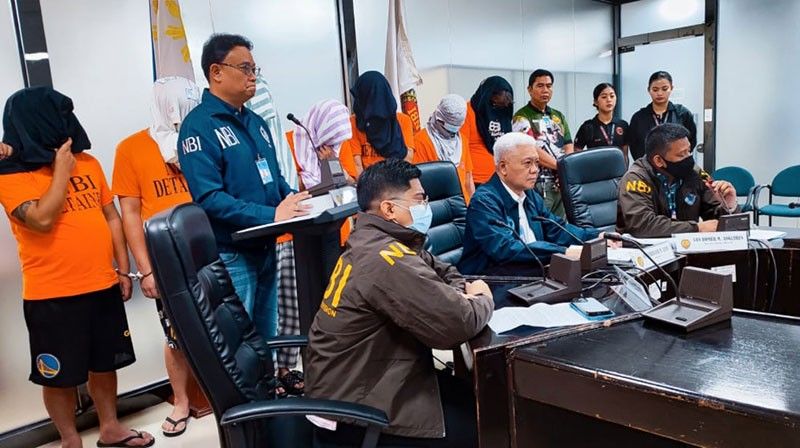Report Chinese spying, other suspicious schemes

The arrest of six suspected Chinese spies in Subic Freeport last week is the fourth Philippine counterespionage strike reported this year alone.
Disguised as game fishermen, the Chinese operated on Grande Island at the mouth of Subic Bay, Zambales, site of the Philippine Navy’s second largest base.
NBI agents monitored them flying drones every time a ship passed by. Seized were gadgets containing photos and videos of Philippine and US naval craft, fleet departure and arrival logs and fake tax documents.
Their Filipino bodyguard illegally carried a firearm during the election ban.
In early January, Makati police nabbed a Chinese with two Filipino accomplices surveilling military and other government facilities in Luzon. Found in their vehicle were a global navigation satellite system and scanning devices to create 3D maps of buildings without physical entry.
Late that month NBI caught five Chinese “tourists” frequenting Ulugan Naval Base in west Palawan. Taken from them were mobile devices containing photos and videos of Philippine Coast Guard stations and vessels and Buliluyan Port in south Palawan.
They turned out to be associated with the Chinese detained in Makati. They had videoed PCG vessels in Manila Bay and Navy movements in Subic.
Four of them led groups affiliated with the China Communist Party. They had donated cash and vehicles to Manila police and Tarlac officials.
In February, NBI presented two Chinese who possessed International Mobile Subscriber Identity catchers, spyware and photographs of Malacañang, US embassy, Villamor Airbase, Camp Aguinaldo AFP headquarters and Camp Crame PNP headquarters.
They paid three Filipinos P3,000 a day to drive them around.
Chinese spying is being exposed as CCP People’s Liberation Army aggression escalates in Philippine seas. The Chinese embassy in Manila dissociates itself from espionage and cyberattacks on Philippine government websites.
Similar incidents are being reported in the US and Australia, whose navies defy Beijing’s claim over the entire South China Sea.
A US court convicted a Chinese national last October for illicitly photographing a submarine base in Norfolk, Virginia. The engineering student from Minnesota travelled 1,300 miles supposedly to vacation in the east coast where, upon arrival, he flew a drone over the restricted area. He was caught because his drone got stuck in a tree.
The incident occurred as US legislators were investigating “growing concerns about drone use near critical infrastructure.”
A month later a Chinese was apprehended flying a drone over Vandenberg Air Force Base, California. Vandenberg hosts satellite launches and missile tests.
Also that month, 12 drones were spotted over Picatinny Arsenal, New Jersey.

Three incidents followed in December. High-altitude, high-speed drones were monitored over Wright-Patterson Air Force Base, Ohio; Camp Pendleton, California and Naval Weapons Station Earle, Colts Neck, New Jersey.
No suspects were arrested in the last four illegal flights. “But the sophistication of these drones suggests they may have been custom-built or derived from military-grade systems,” 3Gimbals geopolitics and business researchers state.
They cited three advanced Chinese drone models: BZK-005, a long-endurance reconnaissance Chinese unmanned aerial systems used by the PLA; TB-001, which combines surveillance and combat capabilities frequently used to trespass Taiwan airspace; CH-4 capable of precision-guided munitions.
“While there’s no conclusive evidence that these specific models were involved in the US incursions, the characteristics of the drones observed are often consistent with these advanced systems,” 3Gimbals says.
In February a large drone that flew between Australia and Papua New Guinea sparked public outrage. The UAS barged six kilometers into PNG airspace, then hovered over Australia’s east coast.
It appeared to have launched from a PLA-Navy frigate that was passing between the two countries. The frigate then joined up with two others for live-fire exercises in waters between Australia and New Zealand. The unannounced drill disrupted commercial flights and navigation.
Australia warned against China-made drones starting 2020. At that time the transport and infrastructure department noted deficiencies in security systems against “malicious use of drones.”
China controlled 75 percent of the global drone market then. One company alone, Da-Jiang Innovations, accounted for 70 percent of sales, $50-$5,000 apiece.
CCP edicts made DJI vulnerable to influencing, Australian officials said. One law compels all Chinese citizens and companies to participate and support state espionage, and to keep it secret. The central committee further dictates the establishment of a CCP cell in each company, preferably chaired by the CEO.
In 2023 the Australian Defence Force suspended the use of DJI drones. The Department of Home Affairs followed suit by suspending other DJI products. So did the Federal Police and the Border Force.
China has fielded sea drones in the Philippines. Five have been interdicted this year: two in Calayan Island, Cagayan and one each in Pasuquin, Ilocos Norte; San Pascual, Masbate and Initao, Misamis Oriental.
PLA-Navy and China Coast Guard warships regularly zigzagged and stopped in archipelagic waters, in breach of international maritime law.
* * *
Follow me on Facebook: https://tinyurl.com/Jarius-Bondoc
Catch Sapol radio show, Saturdays, 8 to 10 a.m., dwIZ (882-AM).
- Latest
- Trending




























